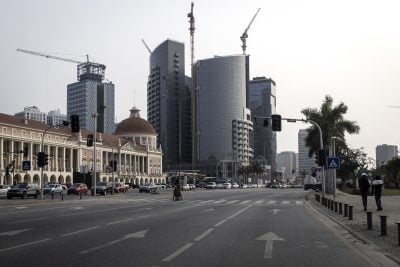Agriculture transformation is one of the four pillars of the current administration. The country has developed flourishing markets in certain cash crops with an integrated and functioning value chain. It has also established itself as a hub for agripreneurs who are redefining farming. Our correspondent in Nairobi, Wanjohi Kabukuru, provides an insight into the country’s successes and challenges.
Every day, fresh flowers, fruits, nuts and vegetables, among other agricultural products, are airlifted to the main markets of Europe and the Middle East through the Jomo Kenyatta International Airport (JKIA) cargo terminal.
One of the agricultural exporters using the JKIA cargo terminal on a daily basis is Africa’s latest agricultural sensation Alex Muli, who at 33 runs the successful Goshen Farm, which recently beat 400 other continental competitors to win the coveted $25,000 African Development Bank’s AgriPitch competition.
Muli’s agripreneurship began in 2010 when he started to farm French beans on family land, using start-up capital of $650 which he borrowed from his mother. He sold the beans at the local market and with time, his model that impressed the judges came into operation – obtaining produce from an increasingly large number of farmers for processing and sale.
Today, Muli sources fresh produce from some 4,235 farmers in Kenya’s eastern region and he has been forced to quit active farming to concentrate on supplying both the domestic and export markets. “I stopped farming so as to concentrate on the export business,” says Muli,
who exports to Europe and the Middle East.
“We still offer technical advice to our farmers, who supply passion fruits, mangoes and French beans to us,” Muli adds as he calls for the reimagining and rebranding of farming on the continent.
“The term ‘farming’ alone is heartbreaking because it depicts a passionate and hardworking Kenyan who can barely make money for their survival. I encourage young people to become agripreneurs as opposed to farmers.
“Farming is where you wake up and go to the farm without even caring about the market. Many people take it as a social activity and that is where we go wrong. We all need to make agriculture commercial.”
Muli is one among many youths who are redefining the face of Kenya’s fast-changing agricultural landscape. Young, energetic, tech-savvy, bold, dashing and innovative characters are transforming the old, tattered and hoe-carrying image of the farmer that was the face of African agriculture.
Technology is also fast embedding itself in the Kenyan agricultural scene, leading to handsome profits and remarkable results being posted in some cases. In the middle of last year, the country’s premier agricultural agency, the Kenya Agricultural and Livestock Research Organisation (KALRO), launched 14 mobile apps designed to assist farmers, and enhance trade and agricultural productivity.
The specifically designed apps cater for diverse and on-demand crops such as bananas, avocadoes, cassava, maize, guava, cowpea and potatoes, giving production details and access to key research.
“We are digitalising our agriculture to help ease agricultural processes, boost electronic commerce and provide open data for future farm use,” says Mwangi Kiunjuri, the cabinet secretary in charge of agriculture and irrigation.
This is not the first time the agricultural research agency has venturing into technology to reach farmers. In 2017, KALRO launched three apps targeting dryland crops, indigenous chicken-rearing and range pasture seed production.
“The digital platforms will help improve research data democratisation and offer insights to inform policies, particularly on improving smallholder farmers’ livelihoods,” says Boniface Akuku, director of ICT at KALRO. “This will help farmers acquire genuine information, unlike the conventional models that can facilitate farmers receiving wrong information that leads to the growing of fake seeds.”
Twiga Foods is a good example of the growing number of technology-focused agri-based entities in Kenya, having now established itself as a market leader in food logistics. In partnership with tech-giant IBM, Twiga runs a mobile-based business-to-business food supply platform, and also facilitates micro-lending alternatives to food retailers.
The statistics clearly show that the agricultural sector still dominates the Kenyan economy. According to the United Nations Food and Agriculture Organisation (FAO), agriculture is a vital component of Kenya’s economy, contributing 26 per cent of GDP and another 27 per cent indirectly, through linkages with other sectors.
The sector employs more than 40 per cent of the total population and more than 70 per cent of Kenya’s rural people. KALRO says that 45% of government revenue is derived from agriculture and the sector contributes more than 50% of export earnings.
Agriculture has dominated Kenya’s economy not just since independence, but going back to the East African Protectorate and Kenya Colony days. For the first 50 years of imperialism and colonialism, agriculture was the main economic driver. Today, after 56 years of independence, the situation is still the same.
Kenya’s bulk exports are agriculture-based – notably tea, coffee, cut flowers, rice, milk, horticulture, nuts and beef. The main source market for Kenyan agricultural produce is the European Union bloc and the Middle East. According to the Fresh Produce Exporters Association of Kenya (FPEAK), fresh fruits, flowers and vegetables are taken daily to their source markets.
The flowers include carnations, roses, lilies, hypericum and alstroemeria. Chillies, aubergines, French beans and snow peas dominate the vegetables for export. Mangoes, pineapples, avocadoes and passion fruits lead the fresh fruits list.
Data from the Kenya National Bureau of Statistics (KNBS) shows that in 2018, Kenya exported products worth $5.1bn. The leading 12 importers of Kenyan products included Pakistan, Uganda, the US, Netherlands, the UK, Tanzania, UAE, Somalia, Egypt, DRC, Rwanda and South Sudan.
But even though Kenya is the world’s leading exporter of black tea, the commodity’s export earnings tumbled this year owing to low market prices. According to the Tea Directorate, production of tea in the first five months of 2018 was 187.69m kilogrammes. This year it has dwindled to 170.18m kilogrammes. Kenya has over 50 varieties of tea, which is in general popular worldwide due to its high quality.
Production of tea in Kenya is undertaken by both large-scale tea growers and smallholder farmers. There are over half a million smallholder tea farmers in Kenya according to the Tea Directorate. Kenya’s main tea markets include the UK, Egypt, Pakistan, Afghanistan and the UAE.
For more than a century, tea has traditionally been grown in Kenya’s central plateaus and the rift valley highlands. These areas include Mount Kenya, the Aberdare Range, Kericho, Nandi and the Kisii highlands, whose acidic soils and favourable climate foster healthy tea bushes. According to the Export Promotion Council (EPC), 95% of Kenya’s tea is exported and Kenya’s tea auction based in Mombasa is the second- largest and busiest in the world.
Previously, coffee was Kenya’s main agricultural export, followed by tea. A series of management blunders, poor regulatory policies, farming disincentives and a lack of commitment by government saw this once-thriving sector collapse.
Agriculture analysts argue that the decline of coffee production has seriously undermined forex reserves and that this has in turn had a huge impact on the economy, as it was one of the key contributors to GDP. The same woes that strangle coffee-growing have brought down the once thriving pyrethrum sector, affecting over 200,000 farmers.
Following tea in export earnings is the flower industry, which brings some $1bn into the economy annually. As with tea, Kenya leads the world as the largest exporter of cut flowers to the European market, with a 38% market share. The main flower-growing areas are around Mt Kenya, Thika, Lake Naivasha, Nakuru, Athi River, Nyandarua, Kiambu, Kitale, Trans Nzoia, Kericho, Uasin Gishu and in eastern Kenya. The sector has 90,000 employees.
Interestingly, while Kenya has distinguished itself as an agricultural economy, only 9% of the country is arable. According to the FAO, the 9% arable land comprises 5.3m hectares. This is not the only interesting aspect of the Kenyan agricultural sector. Ironically, while Kenya is a major exporter of cash crops, it is a net importer of food crops, notably grains. This situation is principally because much of the farming in the country has largely depended on rain-fed agriculture.
President Uhuru Kenyatta’s Jubilee administration’s grand plans to change this grain-importing trend into an exporting one have however stalled. The proposed Galana-Kulalu Irrigation Scheme, launched in 2014 in the Tana Delta region in Kenya’s coastal counties of Tana River and Kilifi, for the purposes of establishing a million acres of irrigated land, with a model farm at the centre, is yet to pick up and has been slowed down by audit queries on sleaze.
The five-year plan, spearheaded by the ministry of agriculture, livestock and fisheries, has seen $42m being set aside for the design of the farm ranch, feasibility studies and the setting up of water points. The million-acre coverage of the project was projected to rise to 1.75 million acres, creating Kenya’s largest piece of farmland. The blueprint indicated that 500,000 acres were to be used for maize, 200,000 acres for beef and game, while 300,000 acres were for sugarcane.
As it developed, 150,000 acres were to be used for horticulture production, dairy was to occupy 100,000 acres and 50,000 acres were zoned for mangoes and guavas. However even with the stalling of the million-acre scheme, a few successful case studies attest to Kenya’s agricultural prowess:
SASINI
Sasini is one of Kenya’s most successful agri-businesses and it is no surprise that the corporate aim is “to be the leading agribusiness in Africa.” It started as a single farm entity in Kiambu in 1952, during the liberation struggle. Its trading name then was Doondu Estates. By 1959 the farm had acquired three more farms. A year later the company changed from being a private enterprise into a public company, in a bid to seek more financial muscle to fund its growth agenda.
In 1964, the company continued its expansion strategy when it incorporated tea and ventured into the Rift Valley by acquiring a stake in Kipkebe Tea Limited. A year later it increased its stake and acquired full ownership of the tea estate. In later years Sasini moved to Nyeri, where it acquired Mweiga Estates Ltd. Today, Sasini, which had specialised in tea and coffee as its primary produce, has diversified to include horticulture, dairy farming and forestry, not to mention coffee mill operations, export trade and lifestyle coffee lounges.
Sasini is involved in the entire value chain in agriculture, from growing through to processing, marketing and retailing agricultural produce. Its most well-known brands are Sasini Tea and Sasini Coffee.
KAKUZI
The story of Kakuzi, which is headquartered in Makuyu in Central Kenya, goes back more than a century. At the time Donald Seth-Smith, financed by Lord Cranworth, acquired some 10,117 hectares in Makuyu. Up until 1966, when they merged into one company, Kakuzi operated as two companies specialising in sisal: Kakuzi Fibrelands had sisal as its main product, and coffee on the sidelines, while Sisal Limited was principally a sisal enterprise.
Competition from synthetic materials saw Kakuzi stop sisal production in 1987, while increasing its coffee production, which it had started in 1919. More interest was also placed in tea farms, which had been acquired in the 1960s but not given much priority over the years.
The 1984 drought forced Kakuzi to diversify. Avocadoes, macadamia nuts, orchards, joint pineapple growing with Del Monte, forestry, horticulture and livestock are today all part of Kakuzi’s portfolio.
Coffee had been produced by Kakuzi since 1919. Around that time, Sisal Limited also started looking further afield and acquired land in the Nandi Hills, which was planted with tea. The company sold green leaf to neighbouring factories for processing into black tea. This arrangement was not satisfactory and when a neighbouring estate, Siret Tea Estate, came on the market, Kakuzi acquired it, complete with a processing factory.
Today Kakuzi is the largest producer of avocado in East Africa, and exports 45% of its total avocado produce from Kenya. Kakuzi employs over 800 workers on a permanent basis.
JAMES FINLAY
James Finlay is renowned for its high-quality, large-scale production of tea. The company, which traces its roots to over two centuries ago, is one of the world’s most successful agribusinesses. Just like Mackinnon, it is a Scottish enterprise which began as a cotton merchandise business. Starting in the US and later expanding to the Indian subcontinent, the company established its presence in Kenya when it sent Indian and Ceylon tea experts in to the country in 1925 to establish large-scale tea farming.
CIRIO DEL MONTE
The investments made by Cirio del Monte, which was originally known as Kenya Canners way back in 1948, have put Kenya among the top five pineapple producers in the world. The company, situated in Kiambu County, Thika, produces solid pineapple, juice concentrate, mill juice and cattle feed, and processes 1500 tonnes of pineapples daily. Europe is the companys largest market.
KETEPA
Well-known tea brand KETEPA (which stands for Kenya Tea Packers) was registered in 1977 but kicked off operations in 1978 in the renowned tea-growing region of Kericho. Up until 1992, KETEPA could only sell its tea in Kenya. This is because the law would not allow it to join the export market. The Kenya Tea Development Agency (KTDA) and the Kenya Tea Growers Association (KTGA) are the main shareholders of KETEPA.
Smallholder tea growers representing some 450,000 farmers across the country, who produce 60% of all Kenyan tea, are represented by KTDA. KETEPA’s other shareholders include Eastern Produce, Williamson Tea, James Finlay and Unilever Tea, and they produce the remaining 40% of all Kenyan tea.
BROOKSIDE DAIRIES
A passage from Duncan Ndegwa’s Walking in Kenyatta Struggles reads: “Kenyatta the farmer kept cows at his Njiru farm on the outskirts of the city and once in a while his journey to the office from Gatundu was interrupted by his urge to see the cows.
He supplied milk to the then Kenyatta College and the cheque he got for it was on occasions, a source of pride that he could not hide. He would keep the cheque in his coat pocket for a long time and when the appropriate moment came, he took it out and displayed it with a sense of satisfaction and said, ‘Who says Kenyatta is not a farmer? Look at this. Is it not a cheque from my milk?’ ” Like many others, that cheque had gone stale and the bank would be forced to issue a replacement.”
Many may not have known it, but this narrative captures the beginnings of Brookside Dairies, which is one of the most successful privately owned dairy firms in East Africa.
Brookside, which is run by the First Family, came into being in 1993 after the Kenyan government privatised the dairy sector. The company, which has a workforce of close to 2,000 employees and produces 700,000 litres of milk daily, is also a leading exporter of all dairy products.
Want to continue reading? Subscribe today.
You've read all your free articles for this month! Subscribe now to enjoy full access to our content.
Digital Monthly
£8.00 / month
Receive full unlimited access to our articles, opinions, podcasts and more.
Digital Yearly
£70.00 / year
Our best value offer - save £26 and gain access to all of our digital content for an entire year!
 Sign in with Google
Sign in with Google 


